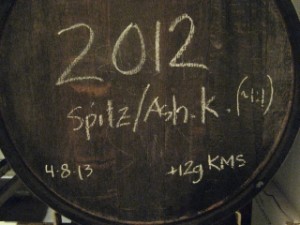Download: 002_Nicole_Leibon.mp3 [35.1MB, 38:11]
ERIC WEST (Intro): Nicole Leibon of Farnum Hill Ciders in New Hampshire joins me for Episode 2. Largely overshadowed by Steve Wood—her highly influential and opinionated boss—Nicole has guided the cidermaking process at Farnum Hill for almost 15 years now. She and I chat about her background in fermentation, her favorite apple varieties for cidermaking, the Farnum Hill house style and their core products, the evolution of the cider industry in the United States, and the influence of women in cidermaking.
Here’s my conversation with Nicole Leibon.

ERIC WEST: Nicole, thanks for making time for me today. The first thing that I wanted to ask you is, what exactly is your official title? And does that really encompass all that you do for Farnum Hill?
NICOLE LEIBON: Thanks for having me on, Eric. My title officially is Cidermaker. It’s sort of a vague title because things have shifted around over the years. When I first started I was doing everything from being out in the field to running the pumps and filling the tanks and doing the filtration. And over time, having had two kids, it’s winnowed down to the point where my specific roles are tasting and blending. And that was something that was always important in what I was doing with doing everything else. But that’s really what my focus is now. It’s kind of fun on days when I go in and actually get to wash a tank again! Instead of just drinking all day.
WEST: So in the past you would’ve been doing things like involved with the milling and the pressing? Or has it always been more just the juice side of things?
LEIBON: Mostly the juice. Some field work. I know how to prune, although I’m not terribly good at it. But as our cider production has gone up, there’s just been more and more work to do in the cider room, rather than being able to get outside. So that was a fairly early transition. When I had my kids I just wasn’t in very much. So the things that Steve really needed for me to do were to do the tasting and the blending. Because I had always had a pretty big role in that, but that turned out to be the thing that I needed to really focus on. Now that’s what I’m doing. And we’re making enough cider that that’s—not a full-time job, but it’s coming up on it.
WEST: When did you start at Farnum Hill? And what sort of background does one have to have to become the cidermaker at Farnum Hill?
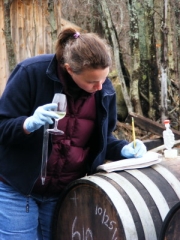
LEIBON: I started in spring of 2000. My background—I don’t actually know what sort of background you need! I had spent some time abroad and had cider in France, in school. And when we moved out here in the fall of ’99, at some point I tried some of the Farnum Hill cider, and that was the first cider that I thought, wow!, this tastes like real cider. And then it turned out that a friend of ours knew Steve and said, oh! you’ve got to go talk to this guy. And I wasn’t working at the time, so I was looking for things to do.
But I had been a brewer previously. So I had done craft brewing. And then I worked for White Labs Yeast—which some people are familiar with—in San Diego. And when we moved out here, I was sort of at sea. When I started talking to Steve, he wasn’t looking to hire anybody. Because cider at that point was still pretty small. And I wasn’t even quite sure that I was looking for a job.
I spent the day with him where he showed me the orchards and he showed me the barrels and then we started tasting things. And somehow at the end of the day, he had hired me and I had a job! I thought that my background of brewing and knowing the clamps and the hoses and how to run a pump and how to clean a tank—I thought that that was why he hired me. And it turned out that he hired me because of my nose and my palate. And the actual physical capability had nothing to do with it.
WEST: That’s interesting. Were you already based in the Lebanon / White River Junction area, is that where you had moved to with your family? And then from there you started looking for a position?
LEIBON: Yes. We had moved from San Diego, my husband got a job teaching mathematics at Dartmouth College. And so I moved out. I had had these thoughts like, I’m doing beer, is this really what I want to do? Is making alcohol contributing anything to the world? And I guess ultimately for me the answer was yes!
WEST: Yeah! One of the things that I wanted to ask you about is how have things changed since you started then in 2000? Has the production volume increased considerably? You talked about how your role has changed, but what has changed with Farnum Hill Ciders since you first started?
LEIBON: The production volume has increased quite a lot. Probably the main thing that’s happened is that when I started there, the cider was in production and we had five varieties in production. But the volume wasn’t very big. And at that time, the apples—the eating apples—were supporting the cider. And that has shifted in the last five years or so. First it was that the cider was beginning to actually support itself. Then recently it’s actually surpassed the eating apple production. Our volumes now are in the 15 to 17 thousand gallon range. And it’s been fairly stable the last couple of years.
About five years ago, the main thing that happened is that our big planting of all cider fruit came into production. That made an enormous increase in the amount of cider apples that we had available to us, and therefore the volume of cider that we could produce from it.
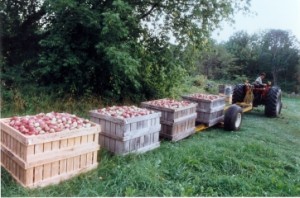
WEST: Right. And that leads into my next question. It seems like you’re in the envious position of having access to all this amazing cider variety fruit, based on Steve’s foresight of where he thought the market was going.
LEIBON: Yes!
WEST: Can you talk about some of those specific varieties that you like working with from the orchard?
LEIBON: Sure! Probably our biggest workhorse is Dabinett, which is an English bittersweet apple. And that one has really nice tannins. The juice—one of the things I do is I taste and test the juice before we actually blend it for fermenation. And I would recommend that to anybody who’s starting out. Getting a sense of what the apples and the juice are like is really useful. The Dabinett has this really lovely strong black tea and apricot flavor. It’s almost like you mixed apricot nectar with really dark black tea. So the tannins are really apparent. But that apricot flavor and the tannin structure will actually follow through into the cider.
We use a fair bit of Ashton Bitter and Yarlington Mill, those are also really useful. And one of the things that we’ve found helpful is that—by having a fairly diverse planting—when we get a very heavy crop one year and then it doesn’t crop very well the following year, by having something that can be a little bit of a stand-in, it helps to make the blending process of the finished cider a lot easier.
For example, a couple years ago we worked with a lot more Ellis Bitter than we had previously. And it turned out that, although we weren’t terribly familiar with it because we hadn’t really had much of it before, we really liked it. And we’ve been finding, going back and tasting, oh this is really good, what was this? And it turns out to have been Ellis Bitter.
And then in terms of other apple varieties, one that we’ve really begun to rely on is called Wickson. And that actually was developed as a cider apple out in California, so it’s relatively recent. A very small, cheery, sprightly acidic apple. That’s one that we use for a lot of acidity. It’s got these amazing profiles in it—I always get lychee out of it. So the Wickson is this really great sprightly acidic—it ferments out very nearly clear because it’s so acidic.
We also use a lot of Esopus Spitzenburg, which is reputed to have been Thomas Jefferson’s apple, it’s a great heirloom. It has this really great rose petal and a little bit of spice that I pick up. And Ashmead’s Kernel, too, is one that we really like. It’s pretty well balanced…generally it’s 60 percent-ish bittersweet apples and then about 15 percent bright acidity—and that varies of course from blend—but the rest of it is made up with the apples that are either heirloom types or something that’s got a little bit of a nice fruity acid in it like Golden Delicious or Golden Russet.
WEST: For the most part, do you ferment the varieties separately and then blend?
LEIBON: We do blending both at the press and during fermentation. Steve is the one who is the mastermind behind blending at the press. We’ve pointed out to him that if he gets hit by a bus we’re all in the tank! Because he hasn’t really been able to articulate to the rest of us how he’s making those decisions. So he blends at the press, and then we end up with different totes full of juice. And then that blending process is based partly on what we know of our history from blends that we’ve liked in the past. But also we’re definitely going for close to 3.5 pH, so that’s pretty critical for us. Those blends change throughout the season. We use Elstar for our acid very early in the season because that’s one of the first one that comes in when we’ve got a lot of Ashton Bitter and Somerset Redstreak. And then as things move in later on, that’s when we can start putting in more of the Esopus Spitzenburg and the Wickson to counteract some of the later bittersweet apples varieties like the Dabinett.
WEST: From my visits there, it seems like a lot of the cider is fermented in neutral oak, is that true?
LEIBON: It’s very neutral oak! It’s so neutral that I haven’t picked up any actual oak flavor or aroma. I’ve been there since 2000 and Steve had already had the barrels for a couple of years. And he had gotten them from a winemaker who had declared them neutral already. So this is 20 years on. They do still round the tannins, they’re very useful. So that’s why we continue to use them. We aren’t looking for oak. So for us, as neutral as they are is perfect.
WEST: Was there an intent by using the oak rather than just using stainless or some other material?
LEIBON: I think a lot of it was the tannin rounding. I think it was just to see what it was going to contribute. The stainless steel is nice in terms of volume, really. And then trying to figure out if size and shape makes a difference. The barrels do seem to have a shape—we think—in their favor. I don’t know quite enough about the dynamics of it to know what it’s doing. But there are some varieties—for example, the Kingston Black—one year we were so lucky that we had enough that we could actually put it in the stainless tank to ferment it. So we did. And it came out fine, but we felt like it was missing a little something.
I’ve had the same feelings about Spitzenburg, which we tend to do in the oak barrels as well. So it’s hard for me to articulate what the difference is in the oak, but it seems to just give the flavors a little bit more oomph and gives it a certain texture that’s a little bit different than when it’s fermented in the stainless. A lot of our stuff is fermented in stainless—the bulk of the volume is—but by the time we get blended, probably in every blend there’s some amount of something that’s been in oak at some point.
WEST: Well personally I like that mystery of not knowing exactly what’s going on.
LEIBON: The whole thing is a mystery! That’s good, I’m glad to hear you say that.
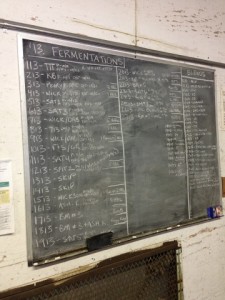
WEST: Does Farnum Hill have a house style, I guess you could say? I know you have a number of different regular releases. But is there something that unites all of the different offerings that Farnum Hill has?
LEIBON: I would say so. I think all of our ciders—sparing the Dooryard—most of our ciders are all sort of recognizable to each other. That is based primarily on the fact that Steve really loves tannins and his wife Louisa Spencer really loves acid. For us, it’s trying to find a balance of a really nice tannic structure with fruit to showcase what we’ve been growing in the orchard. And then a bright clean acid to cleanse your palate toward the end. The finish on the ciders is something that is really critical to us, to make sure that you’re not wishing you could have a glass of something else! So a nice, bright, clean, acidic finish is something that we like.
WEST: And light carbonation—except for the still releases—but is that something that plays a part?
LEIBON: It does. In truth, if we could have our druthers, we would make everything still. I like bubbles personally—mostly we’re doing it because the market still likes bubbles. So when we first started out, for one thing cider was alarming to people in general. But if it didn’t have bubbles in it, it really through them. They couldn’t get their heads around it. That fortunately has been changing. So we’re lucky about that. We want a little bit of bubble in there to make it festive.
In some of the flavors, when we’re blending and when we’re thinking specifically about something that’s going to be fizzed, one of the things we do is—it changes your perception of the acidity, it makes it seem a little bit brighter. So sometimes we think, are we quite there with the acid? And then we think, wait, this is going to get fizzed—in the finished product it will have the acidity that we’re looking for.
WEST: Can you give us a quick walkthrough of your regular labels? Explain how they differ from one another and what you’re trying to achieve with each one?

LEIBON: Sure. Like I said, they’re all recognizable to each other. They’re a family.
We’ve got the Extra Dry. And that one is—the Extra Dry and the Extra Dry Still are not always exactly the same blend. The Extra Dry tends to have a good, solid tannic base. We want it to have an appreciable amount of fruit. And like I was saying, the bright acidity throughout it with the fizz. The Extra Dry Still is one that, it’s probably a little hard to find, because we don’t release very much of it. Steve and I have decided that that’s the one that we really have to make the very best, because it has to stand on its own. There’s no bubbles to hide behind. There’s no sweetening to hide behind. So that one, we want that to have a nice, deep, tannic bass note. A lot of fruit, but not [too] fruity. And also enough acidity to carry and have brightness, but not be overwhelming.
WEST: Before you go on to that, do you consider that to be the most difficult cider to make because of that?
LEIBON: Yes, I do. I’ll talk about the Dooryards in a minute, but we have made a lot of Dooryard still batches because we’ve got something that we don’t quite think qualifies as the Extra Dry Still. I think it’s the hardest one to make.
The Semi-Dry is frequently made from a similar big base as the Extra Dry—not always—but it has more acidity and therefore a little bit more fruitiness to go along with that. Because it’s backsweetened a little bit. We like a tiny bit of sweetening that brings out the fruit. So my analogy for that is we’re sweetening it in the same way that you would salt your food—you want to bring forward the flavors, but you don’t want to taste the salt. We don’t care for very sweet ciders, so none of our ciders are sweet. But the Semi-Dry has to have enough acidity to be able to support the little bit of sugar that we add to really bring those fruit flavors forward. The Semi-Dry seems to be one of the ones that’s our most popular. There are people who are extremely faithful to it.
And then we’ve got our Farmhouse. That one’s got a little bit lower alcohol, it’s sort of a pub style, it’s a little bit more casual. It tends to have a little bit more tannin to it than the other ones do. It’s maybe not quite as brightly acidic as the others. It’s got a little bit of backsweetening to it, but not much. It’s a little bit more of an English style cider in that the tannins are a little bit more forward, and the fruit is there, but it’s not quite as brightly acidic. Those are the main ones that we have now.
And then we’ve got the Dooryard. Which was something that developed sort of on accident, a little bit. We decided to start selling growlers. “Dooryard” is what New Englanders call the driveway—I had no idea, I came out from California and was like, the where? For people who have been to Poverty Lane Orchards, there’s this big driveway and this spot that dumps you into the middle of where the barn is and where the farmhouse is and things like that—and that’s the dooryard. The growlers were from kegs that we’d made from what was left in the hoses after we’d transferred a tank. And so it was something that was usually sort of halfway to being a finished blend, but maybe not quite there. Maybe we hadn’t quite acidified it as much as the finished blend was going to be, or something like that.
We found that people liked having things like that. So the Dooryard just sort of grew out of having cider that couldn’t really be put into the boxes of our regular varieties. It didn’t want to be an Extra Dry, and we couldn’t make it turn into a Farmhouse. And so we said OK, look, people have enjoyed coming here for the growlers, so let’s have something that is a little different—and we’ll tell them what’s different about it—and we’ll see how it goes.
The Dooryard thing has been tricky. On every single bottle there is a number. And that number is the batch number. And then we put up on our website the tasting description of that. It’s pretty variable. They’re usually recognizable to farmhouse ciders, they’re not that far out of the box. But some of them might be much more acidic. Some of them might be much, more tannic than what we would normally make. And they’re just ones that didn’t quite fit with the regular labels, but that we liked. So our determining factor for the Dooryard is that it has to be something that we think is delicious and that we would drink.
WEST: Is that released in—some of it in bottles, some of it in kegs?
LEIBON: That’s one of the things that we put on the website, whether it’s in just kegs or in just bottles. It’s actually started to become what is going into kegs. It got tricky for people who would say, I want kegs of Semi-Dry to have at the pub. If we didn’t have Semi-Dry that was being made, we just didn’t have any to fill kegs with. So we finally decided that the easiest thing to do was to say, OK, look, we’re always going to have a Dooryard available. So what we’re going to put in kegs is Dooryard. Get a number, and then you’ll be able to track the description on the website and see what it is.
WEST: And so when people come to fill growlers, is the Dooryard the only thing that’s available to them? Can they get some of the other blends as well?
LEIBON: No! The growler people get a little bit of everything. In fact, we end up with this great line of people who will come if we happen to have Kingston Black in kegs that we do for growlers. We make sure that we let people know—OK, we’re going to be doing this—and if we know ahead of time, we’ll tell the people that have been coming in. We try to have people get on our growler email list. And some of it’s marketing stuff, but it’s just to say this is the day—because it varies a little bit, particularly in the wintertime, our dooryard can get really icy, and those are not good days to have people coming in and carrying around big glass jugs! The growlers are still the same as it ever was. There might be a couple of kegs of Extra Dry that we made while we were bottling it. Or there might be a keg that’s some great proportion of Wickson because we were blending it into something else and there was a little bit left in the hoses, that kind of thing. It’s a complete mish-mash what you get for growlers. But usually there’s at least two or three different options, so we let people try them and then decide which one they’d like. Sometimes people blend on the spot. They’ll be like, well, I kind of want half of this and half of that. And we’re like, sure, you can do that!
WEST: Do you find that you’ve built a loyal customer base over time? And are they becoming more educated about cider? Not just your ciders, but about cider in general?
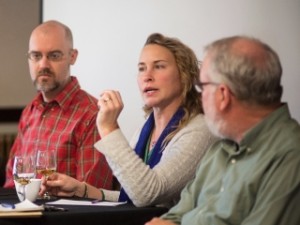
LEIBON: They’re definitely loyal, I will say that, absolutely. They certainly are more educated about our ciders. And I would say that in general, because they have tried our ciders, it makes them more willing to try other ciders. They tend to be somewhat more opinionated about those other ciders than the normal market would be. But it’s neat to hear back from other people, they’ll be like, I tried this one and I liked it. Sometimes they’ll ask us if there are other varieties of cider that we like, and we’ll them which ones we think are pretty good.
WEST: One of the other things that I wanted to ask you about, too, is I know that when I visited—I can’t remember how long ago it’s been—but I had a perry. Are there other things that just aren’t released that regularly? That may not be a Dooryard release, but maybe a single-variety or a perry or something like that?
LEIBON: Yes. We’re wrestling with that a little bit. The perry trees are notoriously fickle. They don’t like it when it gets too cold. So we’ll get a crop maybe two years in a row, and then we won’t hear anything from the trees for like five years. To get it into bottles, it has to be really good. So that’s why we don’t necessarily bottle the Kingston Black every year. Because sometimes it’s just a little bit too weird. It’s weird anyway! It’s weird and it’s variable. But there are some years that we just think, you know, we don’t really like this enough.
The perry, we like it enough, but we’re still learning about it. We’re still trying to figure out what we like and what we think is perry that we want to put into bottles. And there’s a lot of other ones! Steve and I are having an argument just right now, in fact, about a puncheon of Ribston Pippin. Which every couple of years comes out just gorgeous. The fruit itself, if you’ve ever eaten a Ribston Pippin, it’s very rich, and it’s got this nice acidity, but it’s got this sweetness along with it, and it’s just full of flavor.
I keep advocating for doing special reserve bottling of it. But Steve has been pretty strong about sticking to his wife Louisa’s line that if it’s good cider, put it in a blend and make really good cider out of it! There’s a huge amount of weight to be had on that, the answer to that should be, oh, right, of course. But it also turns out to be a little tricky. Once you do end up with, say, 25 or 50 cases of a particular thing, then what do you do with it? Who gets it? Where does it go? That gets a little tricky as well. One year we did perry, and we never quite figured out where to sell it. I think most of it just got handed out to people that visited, and probably that’s what you had!
WEST: That’s one of the things I wanted to go to next. It seems like more and more consumers are becoming interested in things like single-variety ciders and perries and some of the more esoteric things. Since you started as the cidermaker there, how do you perceive that the cider industry has changed around you? And has Farnum Hill adapted to that? Or is Farnum Hill leading the way? Can you talk about that evolution of the cider industry in the US?
LEIBON: There have been enormous changes. We’ve tried to get cider down into New York, in the city. And we made some forays down there and into Washington DC, back in 2002 and 2003. People would walk by in the wine shops, and look at you out of the corner of their eyes, like you had three heads. It was all that they could do to not put their hands up and shield their eyes from you while they walked straight to whatever it was that they were there for. The only people that I could get to stop and talk to me usually were people who were British. And 80 percent of them said, oh, I drank too much of that in university, I can’t do cider. It was this huge—people just didn’t have a place in their brain to put it. In New England, when people say cider, they mean the fresh, cloudy stuff that’s in a jug that you get in the fall. In California, where I grew up, cider meant Martinelli’s, which was really sweet, fizzy apple juice in the little apple jar.
WEST: Which you can find in pretty much any supermarket now.
LEIBON: Exactly, right! People have these perceptions of what cider is. Usually the only people that were actually interested in what we were doing were people that had traveled to somewhere else in the world—England or France or even Spain—that still had robust cidermaking practices. So they’d run into it there. And were greatly surprised to find that there was something similar to that in the US.
I had a couple of kids, I wasn’t there for a lot. And then we went back, I went down to New York again for the first time in 2011. It was the first year that New York Cider Week happened. And people just loved us! I would go in and say, hi, I’m from Farnum Hill, expecting the same What? Who are you? And they would be like, oh, Farnum Hill, we love you guys, you’re so great! And I was completely flabbergasted.
So a lot of this is because, throughout that time, we’ve been slogging away, trying to explain to people what cider is. Louisa Spencer has been behind quite a lot of that. She’s put a lot of pavement time in. It’s a little bit magical to me. But it’s also the result of a lot of really hard work. There’s a lot more people interested in it now, and there’s a lot more people that are making very good cider now, which is I think is the difference. There just wasn’t a lot of cider production in the United States back in the early 2000s. And the people who were making it were either very small, very regional people, or—I have to admit that in the mid-’90s I drank a lot of Wyder’s Pear Cider when I lived in Seattle. And when I went back a couple of years ago and had some, I was completely aghast with myself!
People are beginning to realize that it’s actually something really interesting. And it’s something to try. Because I came from brewing, I see a lot of parallels with the explosion in the craft brewing industry. First it’s the little, little, little grow, little grow, little. And then I feel like right now we’re on the exponential growth curve, which is fantastic. But it’s the same sort of thing, all the big boys are getting in, they’re spending a lot of money—which for us, is great, because they’re telling a bunch of people to go drink cider and we don’t have to pay to have people told that. So we think it’s all good! And then, at some point, the same thing as with any industry, I presume that there’s probably going to be a shakedown. And whoever’s left standing are the people that make good cider that people want to drink.
WEST: In speaking with Steve, I think he feels the same way. I trust him to see the trends happening. I hate that to be the case. But having been a beer enthusiast myself, I do know that there have been dips in the meteoric of craft beer. So despite the fact that are—I don’t know what it is—over 3,000 breweries in the US, there are a lot that have gone by the wayside, too, as part of that growth.
One thing that I wanted to finish with, Nicole, is my entry into the world of cider was through Diane Flynt at Foggy Ridge Cider. She’s kind of my local cidermaker.
LEIBON: She’s a good person to learn from!
WEST: Yeah. I felt that because I learned about cider from her—and I’ve met other women cidermakers in Virginia, like Courtney Mailey at Blue Bee in Richmond—I just assumed that there were more women cidermakers out there. Is that something that you’re surprised about, that there aren’t more women in cidermaking?
LEIBON: I’m a little bit surprised. I think because I know Diane Flynt, and because Louisa is so very involved in what we’re doing, I had the perception that there were more women. And Eleanor Leger from Eden Ice Cider. But I’ve judged at GLINTCAP out in Michigan for the last three years, and there were not a lot of women there. And so I was realizing that there probably aren’t as many women in cidermaking as I had thought.
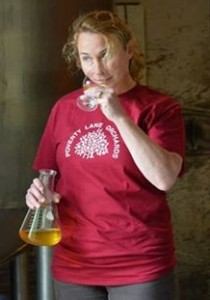
But I also wonder if part of that perception is who the […] are. I’ve been a cidermaker with Steve Wood for almost 15 years, and there’s probably a handful of people who know about me! Which is fine with me, but what that does is that gives the perception that Steve—who co-owns the business with the wife, and his wife has been extraordinarily involved and is deeply integral to the program. And me—and there’s other women that work with me—I know a number of other husband-and-wife cidermaking teams. I’m thinking of Dan Wilson and his wife with Slyboro. I’m wondering if that perception is just that there are probably more women involved who simply just aren’t out there as visible as the men are. That’s I suppose an historical issue for us. But that’s something I’m actually curious about myself.
WEST: Well it seems like running a small business, like a small scale cidery, does require an entire family’s effort to make it succeed. I think I agree with you, there probably are a lot of women behind the scenes. A trend that I would like to see continue is that it seems like there are a number of homestead/farmstead scale cidermaking—people who may be interested in organic agriculture or something like that—getting into fruit growing and cidermaking. And I think it’d be wonderful if we had a lot of families out there across the country being able to support themselves through cider. I think that would be fantastic.
LEIBON: Autumn Stoscheck at Eve’s Cidery is a really good example of that. She started it, and her husband works with her, and their company supports basically another family working with them as well as a couple other people. For us, there’s actually two components of what you’re saying—and I completely agree with you, I think that it would be great to see that. It would support more families being able to work in things together. But also what it’s doing is making the kind of cider that we really appreciate—in part because that’s what we’re doing, which is making orchard-based cider. And focusing on the fruit that’s going into the cider. For us, that’s really critical. Being able to grow good fruit to make good cider, and for other cidermakers to have access to good fruit so that they can also make good cider. And I think that that probably is also contributing to the fact that there are more and more ciders out there that are really well made.
WEST: Yeah, it’s an exciting time for cider.
LEIBON: It is! It really is!
WEST: Well, Nicole, thanks for speaking with me today. And thanks for making such great quality ciders there at Farnum Hill. And thanks to everyone there at Poverty Lane Orchards for doing what they’ve done to raise public awareness—and awareness in the trade—about cider. Thanks so much for what you do and thanks for speaking with me today.
LEIBON: Thanks, Eric! I’m happy to have been on, thank you for having me. And cheers to everybody and thanks for supporting cider in general.
WEST: Awesome. Thanks, Nicole.
LEIBON: Alright, thank you.
WEST (Outro): It was a pleasure to talk with Nicole and I hope you enjoyed our conversation. Nicole has an amazing palate and—despite not being very well known—is one of the very best cidermakers in the United States. Farnum Hill has an outstanding reputation for quality, and Nicole’s cidermaking skill is a major reason why.
For more on Poverty Lane Orchards and Farnum Hill Ciders, visit their website at povertylaneorchards.com. You can also find Farnum Hill on various social media platforms—particularly Facebook—at facebook.com/FarnumHillCiders.
